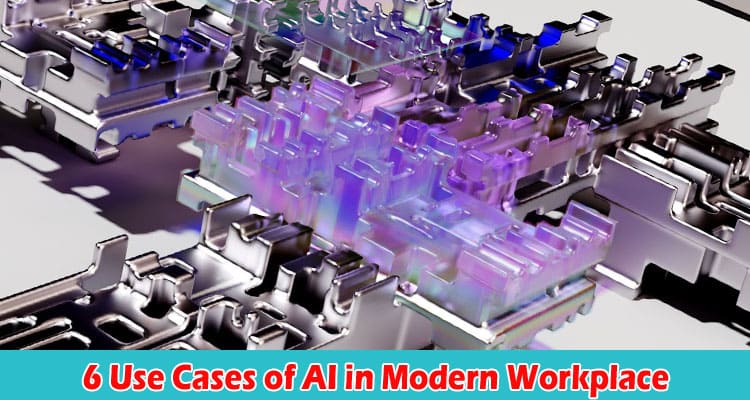In the ever-evolving landscape of modern workplaces, the integration of Artificial Intelligence (AI) is no longer just a trend – it’s a necessity. AI-powered tools and technologies are transforming the way we work, enhancing productivity, streamlining processes, and enabling smarter decision-making.
From data management to automation, AI is making its presence felt across various industries. In this article, we’ll explore six compelling use cases of AI in the modern digital workplace.
Data Management
In the era of data-driven decision-making, generative AI emerges as a game-changer, automating data entry, classification, and organization with remarkable precision. Let’s explore how this AI marvel transforms your data management processes.
- Automated Data Entry. Gone are the days of manual data entry. AI-driven solutions like ChatGPT can extract valuable information from documents, emails, and other sources, reducing the risk of errors and saving valuable time.
- Data Classification and Organization. ChatGPT can categorize and organize vast datasets efficiently. It can help businesses structure their data, making it easily accessible and ready for analysis.
- Natural Language Processing (NLP). ChatGPT can understand and interpret human language, making it an ideal tool for handling unstructured data. It can extract insights from text, enabling better decision-making.
- Data Cleansing. ChatGPT can identify and rectify data inconsistencies, ensuring that the data used for analysis is accurate and reliable.
- Data Security. ChatGPT can play a role in enhancing data security by identifying potential vulnerabilities and suggesting improvements in data handling processes.
Virtual Assistants and Chatbots
Imagine having a tireless assistant at your beck and call 24/7, handling routine tasks efficiently and responding to inquiries with lightning speed. AI-driven virtual assistants and chatbots are the modern workforce’s best-kept secrets.
- 24/7 Support. AI-powered chatbots and virtual assistants provide round-the-clock support, answering queries and providing information to employees and customers, improving efficiency and customer satisfaction.
- Task Automation. Routine tasks like scheduling meetings, sending reminders, and generating reports can be automated with AI-driven virtual assistants, freeing up employees’ time for more strategic activities.
- Multi-Language Support. AI chatbots can communicate with customers and employees in multiple languages, breaking down language barriers in a global workplace.
- Personalized Response. Chatbots can provide personalized responses based on individual preferences and historical interactions, enhancing the user experience.
Predictive Analytics
Peering into the future is no longer a fantasy. Predictive analytics, powered by AI, has the uncanny ability to forecast customer behavior, employee performance, and even equipment maintenance needs. Here’s how it reshapes the business landscape.
- Customer Behavior Analysis. AI can analyze customer behavior data to predict trends and preferences, enabling businesses to tailor their products and services accordingly.
- Employee Performance Forecasting. Predictive analytics can forecast employee performance, helping HR departments make data-driven decisions about promotions, raises, and training.
- Supply Chain Optimization. Predictive analytics can optimize supply chain management by forecasting demand, reducing inventory costs, and improving order fulfillment.
- Financial Forecasting. AI can predict financial trends, helping companies make informed decisions about investments, budgeting, and risk management.
- Maintenance Predictions. In industries like manufacturing, AI can predict equipment failures and maintenance needs, reducing downtime and costly repairs.
Employee Training and Development
Personalized learning journeys, data-driven performance assessments, and proactive skill gap identification—AI is revolutionizing the way companies nurture talent and foster employee growth. Let’s delve into this HR transformation.
- Personalized Learning. AI can create personalized learning paths for employees based on their skills and performance, ensuring that training programs are tailored to individual needs.
- Performance Assessment. AI can assess employees’ performance objectively, providing valuable insights for both employees and managers to identify areas for improvement.
- Skill Gap Analysis. AI can identify skill gaps within the workforce and recommend relevant training modules to bridge those gaps.
- Continuous Feedback. AI-driven systems can provide continuous feedback to employees, helping them stay on track with their career development goals.
Cybersecurity
As cyber threats grow in sophistication, AI steps in as the vigilant guardian of your digital fortress. Discover how AI’s threat detection and anomaly analysis fortify your cybersecurity defenses in real-time.
- Threat Detection. AI can detect and respond to cybersecurity threats in real-time, helping organizations safeguard their data and systems against cyberattacks.
- Anomaly Detection. AI algorithms can identify unusual behavior patterns in network traffic and user activity, allowing for proactive threat mitigation.
- Security Patch Management. AI can assist in identifying and prioritizing security patches, ensuring that critical vulnerabilities are addressed promptly.
- User Authentication. AI can enhance user authentication with advanced techniques like biometrics and behavioral analysis, making systems more secure.
Workflow Automation
Picture a workplace where repetitive tasks vanish, collaboration soars, and efficiency reigns supreme. AI-driven workflow automation brings this vision to life, optimizing your business processes with remarkable ease.
- Streamlined Processes. AI-driven workflow automation can reduce manual intervention in repetitive tasks, optimizing business processes and reducing operational costs.
- Enhanced Collaboration. AI can facilitate better collaboration by automating document sharing, task assignments, and project management, ensuring teams work seamlessly.
- Integration with Existing Systems. AI can integrate with existing software and systems, making it easier to implement automation across various departments.
- Real-Time Alerts. Workflow automation can trigger real-time alerts and notifications, ensuring that issues are addressed promptly.
Final Thoughts
As AI continues to advance, its influence on the modern workplace will only grow. From revolutionizing data management with tools like ChatGPT to enhancing customer service with chatbots and improving decision-making with predictive analytics, AI offers a plethora of opportunities for businesses to thrive in today’s fast-paced world.
However, it’s crucial to remember that while AI can automate tasks and provide valuable insights, it should be integrated thoughtfully and ethically. Human oversight remains essential to ensure that AI systems align with an organization’s goals and values.
Embracing AI in the modern workplace empowers organizations to stay competitive, agile, and customer-focused in a rapidly changing world. With the right approach, AI can be a powerful ally in achieving business objectives and staying ahead of the curve.







